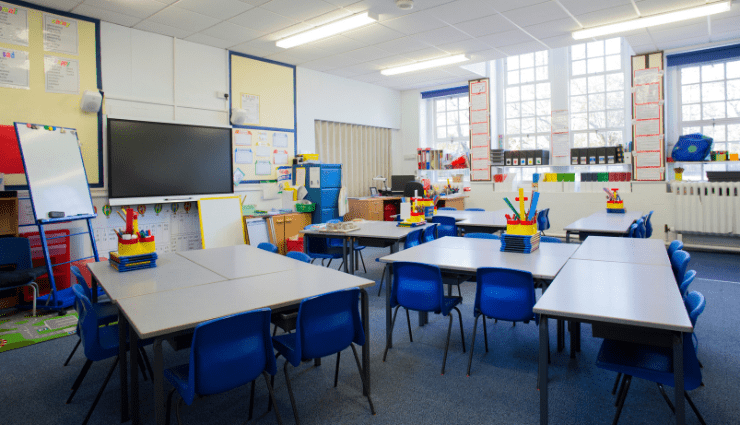08/21/2023 by Lane Dussault |
The Schoolroom
5 Things to Consider as You Set Up Your Classroom This Year

While there are still beautiful summer days to enjoy before the new school year begins, teachers across the country are already organizing their classrooms for the new group of students they will welcome in the coming weeks. Whether you are a seasoned educator, or just beginning your career as a teacher, setting up your space is an essential part of the process.
The traditional model of desks in symmetrical rows may work for some, but others might want to try and different approach. You and the students will be spending much of your day in this environment, so be sure to take some time to think about your goals and how the room can help you reach some of those goals.
Here are a few ideas to get you started.
1. Be intentional about the seating arrangements.
Over time, seating charts have become an important focus for many teachers as our knowledge of learning styles and pedagogy has evolved. Each teacher will have their own intentions when it comes to seating arrangements. However, here are some things to consider. If you hope to create a more collaborative learning environment, create areas that allow for small group learning and discussion groups. Also, think about how you will be delivering instruction. Will you be at the head of the class delivering lectures, or will you be rotating throughout the room to work more individually with students? Project-based, hands-on learning is also on the rise, so think about flexible seating so that groups might be able to use tables and chairs in a variety of different configurations throughout the day. Lastly, are there opportunities for students to work alone or in a quieter more comfortable space? Bean bag chairs and rockers can help students move their bodies without distracting them from the task at hand, allowing them to feel calm and focused.
2. Think about lighting!
No matter where you are teaching, almost every classroom is equipped with harsh, florescent, overhead lighting. While this ensures that everyone can see their work clearly, it doesn’t always make us feel our best. In fact, some studies have shown that it can create an overall feeling of fatigue. It is not always possible to get around this, but taking breaks from the stress and strain of florescent light should be on the agenda. Incorporating small table lamps, white string lights, or LEDs can shift the mood in a classroom space to one that promotes peace and tranquility between assignments. A little lighting can go a long way!
3. Welcome students each day with a constant.
In an ever-changing world where the unexpected is to be expected, it is important that students feel that they can count on something consistent that brings them a feeling of joy and safety. Teachers do this in a variety of different ways, but it often starts with the beginning of the day. Whether it be greeting your students at the door with a special handshake or words of affirmation, sharing an inspirational quote, or simply displaying your schedule for the day at the front of the room, providing a classroom environment where students know they can look forward to something as well as count on something, can reduce anxiety and improve engagement. How you choose to do that is up to you. However, maybe think twice before giving a surprise pop quiz first thing in the morning. We all deserve to start the day off with a positive outlook.
4. Give students choices.
Creating spaces and places for students to interact with learning material on their own can improve student effort and performance. Students finish assignments at different times and need opportunities to continue learning in ways that feel self-directed. Areas of the classroom that provide books, puzzles, and activities that continue to boost brain development but also encourage a love of learning can maximize the time students spend actively engaged. If a student is interested in the history of basketball or wants to learn more about astronomy, this area of the classroom gives them the chance to explore these topics. Sometimes, giving it a cool name with appropriate signage that you can refer to throughout the day can also prove effective. Eventually, it will become second nature for the students to head off to this activity area after completing a task.
5. Think about your own workspace.
Teaching is one of those jobs where you can turn around and ask yourself, “Have I sat down today?” Sometimes, the answer will be no. This makes it much more important to examine what your own workspace will look like over the course of the year. While it is a place where you might complete your lesson planning and grading, it may also be where you need to recharge and reset. A comfortable chair, pillows, photos that bring you joy, or images of serene landscapes might be something to add to your work area. Plants and flowers can also bring a sense of calm to any environment. Don’t skimp on the things you need to do your job well. You can make areas of your classroom feel more like a home than an office space.
Want to explore career opportunities in independent schools? Carney, Sandoe & Associates is here to help teachers, staff, and administrators like you find jobs in K-12 independent schools across the United States — for free.
Learn more about us here or contact us today to discuss your job search.
Leave a Comment
0 Comments
There are no comments on this blog entry.